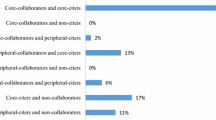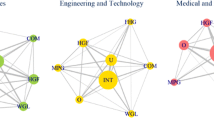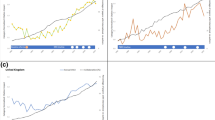Abstract
International collaboration enhances citation impact. Collaborating with a country increments the citations received from it. But some collaborating countries provide greater increments in this sense than others, and likewise some countries receive greater increments from their partner countries than others. We observed a certain tendency for these increments to be lower in countries with greater impacts. Also, all the countries studied had higher Domestic Impacts as a result of collaborating, although this increment was less than that obtained from other countries. Finally, there were differences in the behaviour of the countries between the various scientific disciplines, with the effects being greatest in Social Sciences, followed by Engineering.









Similar content being viewed by others
References
Abt, H. (2007). The frequencies of multinational papers in various sciences. Scientometrics, 72(1), 105–115.
Aksnes, D. (2003). Characteristics of highly cited papers. Research Evaluation, 12(3), 159–170.
Ardanuy, J. (2012). Scientific collaboration in Library and Information Science viewed through the Web of Knowledge: the Spanish case. Scientometrics, 90(3), 877–890.
Ardanuy, J., Urbano, C., & Quintana, L. (2009). A citation analysis of Catalan literary studies (1974–2003): Towards a bibliometrics of humanistic studies in minority languages. Scientometrics, 81(2), 347–366.
Bandyopadhyay, A. K. (2001). Authorship pattern in different disciplines. Annals of Library and Information Studies, 48(4), 139–147.
Bandyopadhyay, A. K. (2004). Authorship collaboration in physics philosophy and political science, IASLIC National Seminar, 11th. Kolkata, 2004, 405–409.
Bridgstock, M. (1991). The quality of single and multiple authored papers- an unresolved problem. Scientometrics, 21(1), 37–48.
Chinchilla-Rodríguez, Z., Vargas-Quesada, B., Hassan-Montero, Y., González-Molina, A., & Moya Anegón, F. (2010). Newapproach to the visualization of international scientific collaboration. Information Visualization, 9(4), 277–287.
Ding, Y., Foo, S., & Chowdhury, G. (1999). A bibliometric analysis of collaboration in the field of information retrieval. The International Information & Library Review, 30(4), 367–376.
Figg, W. D., Dunn, L., Liewehr, D. J., Steinberg, S. M., Thurman, P. W., Barrett, J. C., et al. (2006). Scientific collaboration results in higher citation rates of published articles. Pharmacotherapy, 26(6), 759–767.
Franceschet, M., & Costantini, A. (2010). The effect of scholar collaboration on impact and quality of academic papers. Journal of Informetrics, 4(4), 540–553.
Kraut R., Egido C., & Galeguer, J. (1988). Patterns of contact and communication in scientific research collaboration. ‘CSCW ‘88: Proceedings of the 1988 ACM conference on Computer-supported cooperative work’, ACM, New York, NY, USA, pp. 1–12.
Garfield, E. (1979). Is citation analysis a legitimate evaluation tool? Scientometrics, 1(4), 359–375.
Gazni, A., & Didegah, F. (2011). Investigating different types of research collaboration and citation impact: A case study of Harvard University’s publications. Scientometrics, 87(2), 251–265.
Glänzel, W. (2001). National characteristics in international and scientific co-authorship relations. Scientometrics, 51(1), 69–115.
Glänzel, W. (2002). Coauthorship patterns and trends in the sciences: A bibliometric study with implications for database indexing and search strategies, 1980–1998. Library Trends, 50(3), 461–473.
Glänzel, W., & Schubert, A. (2001). Double effort = Double impact? A critical view at international coauthorship in chemistry. Scientometrics, 50(2), 199–214.
Glänzel, W., Schubert, A., & Czerwon, J. (1999). A bibliometric analysis of international scientific cooperation of the European Union (1985–1995). Scientometrics, 45(2), 185–202.
Goldfinch, S., Dale, T., & De Roue, K. (2003). Science from the periphery: Collaboration network and « Pheriphery effects » in the citation of New Zeland Crown Research Institutes articles, 1992–2000. Scientometrics, 57(3), 321–337.
Hsu, J. W., & Huang, D. W. (2010). Correlation between impact and collaboration. Scientometrics, 86(2), 317–324.
Inzelt, A., Schubert, A., & Schubert, M. (2009). Incremental citation impact due to international co authorship in Hungarian higher education institutions. Scientometrics, 78(1), 37–43.
Katz, J. S. (1994). Geographical proximity and scientific collaboration. Scientometrics, 31(1), 31–43.
Katz, J., & Hicks, D. (1997). How much is a collaboration worth? A calibrated bibliometric model. Scientometrics, 40(3), 541–554.
King, D. A. (2004). The scientific impact of nations. Nature, 430, 311–316.
Lancho-Barrantes, B. S., Guerrero-Bote, V. P., Chinchilla-Rodríguez, Z., & Moya-Anegón, F. (2012). Citation flows in the zones of influence of scientific collaborations. Journal of the American Society for Information Science and Technology, 63(3), 481–489.
Leimu, R., & Koricheva, J. (2005). Does scientific collaboration increase the impact of ecological articles? BioScience, 55(5), 438–443.
Leta, J., & Chaimovich, H. (2002). Recognition and international collaboration: The Brazilian case. Scientometrics, 53(3), 325–335.
Lewinson, G., & Cunningham, P. (1991). Bibliometric studies for the evaluation of trans-domestic research. Scientometrics, 21(2), 223–244.
Luukkonen, T., Tijseen, R. J. W., Persson, O., & Sivertsen, G. (1993). The measurement of international scientific collaboration. Scientometrics, 28(1), 15–36.
Ma, N., & Guan, J. C. (2005). An exploratory study on collaboration profiles of Chinese publications in Molecular Biology. Scientometrics, 65(3), 343–355.
Moed, H. F., De Bruin, R. E., Nederhof, A. J., & Tijssen, T. J. W. (1991). International scientific co operation and awareness within the European Community: Problems and perspectives. Scientometrics, 21(3), 291–311.
Molteni, V., & Zulueta, M. A. (2002). Análisis de la visibilidad internacional de la producción científica argentina en las Bases de datos Social Science Citation Index y Arts and Humanities Citation Index de 1990–2000: Estudio bibliométrico. Revista Española de Documentación Científica, 25(4), 455–465.
Moya-Anegón, F., Chinchilla-Rodríguez, Z., Corera-Álvarez, E., González-Molina, A., Hassan-Montero, Y., & Vargas-Quesada, B. (2008). Indicadores bibliométricos de la actividad científica española: 2002–2006. Madrid: FECYT.
Moya-Anegón, F., Chinchilla-Rodríguez, Z., Vargas-Quesada, B., Corera-Álvarez, E., Muñoz-Fernández, F. J., González-Molina, A., et al. (2007). Coverage analysis of Scopus: A journal metric approach. Scientometrics, 73(1), 53–78.
Narin, F., Stevens, K., & Whitlow, E. (1991). Scientific cooperation in Europeand the citation of multidomestically authored papers. Scientometrics, 21(3), 313–323.
Pao, M. L. (1981). Coauthorship as communication measure. Library Research, 2, 327–338.
Persson, O., Glänzel, W., & Danell, R. (2004). Inflationary bibliometric values: The role of scientific collaboration and the need for relative indicators in evaluative studies. Scientometrics, 60(3), 421–432.
Price, D. J. S., & Beaver, D. B. (1966). Collaboration in an invisible college. American Psychologist, 21(11), 1011–1018.
Scimago Journal & Country Rank. (2008). SCImago Research Group. Accessed 26 March, 2009 http://www.scimagojr.com/.
Singh, J. (2005). Collaborative networks as determinants of knowledge diffusion patterns. Management Science, 51(5), 756–770.
Sooryamoorthy, R. (2009). Do types of collaboration change citation? Collaboration and citation patterns of South African science publications. Scientometrics, 81(1), 177–193.
Sudhier Pillai, K. G. (2007). Authorship patterns in physics literature: An informetric study on citations in doctoral theses of the Indian Institute of Science. Annals of Library and Information Studies, 54, 90–94.
Zhao, Q., & Guan, J. (2011). International collaboration of three ‘giants’ with the G7 countries in emerging nanobiopharmaceuticals. Scientometrics, 87(1), 159–170.
Zuckerman, H. A. (1968). Patterns of name ordering among authors of scientific papers: A study of social symbolism and its ambiguity. American Journal of Sociology, 74, 276–291.
Acknowledgments
This work was financed by the Junta de Extremadura e Consejería de Educación Ciencia & Tecnología and the Fondo Social Europeo as part of the pre-doctoral studentship PRE07052 and the research group grant GR10019, and by the Plan Nacional de Investigación Científica, Desarrollo e Innovación Tecnológica 2008e2011 and the Fondo Europeo de Desarrollo Regional (FEDER) as part of research projects TIN2008-06514-C02-01 and TIN2008-06514-C0202.
Author information
Authors and Affiliations
Corresponding author
Rights and permissions
About this article
Cite this article
Lancho-Barrantes, B.S., Guerrero-Bote, V.P. & de Moya-Anegón, F. Citation increments between collaborating countries. Scientometrics 94, 817–831 (2013). https://doi.org/10.1007/s11192-012-0797-3
Received:
Published:
Issue Date:
DOI: https://doi.org/10.1007/s11192-012-0797-3




